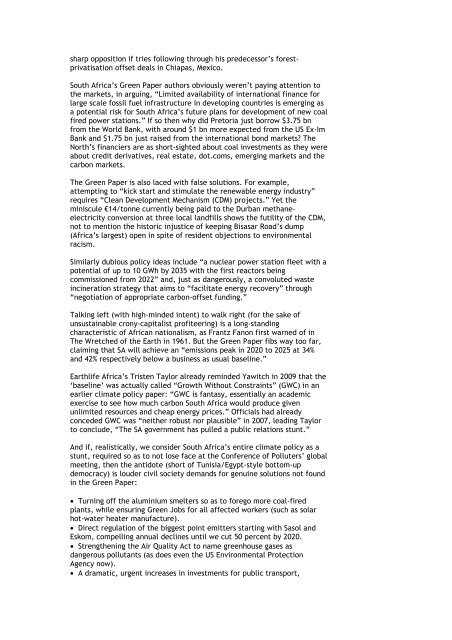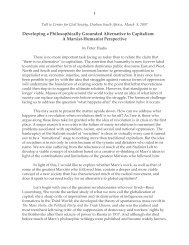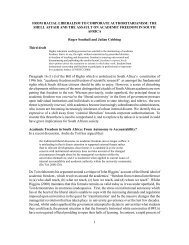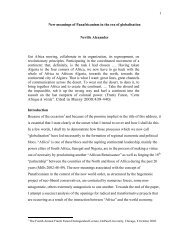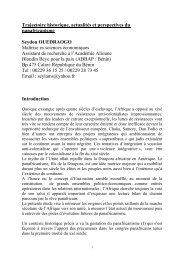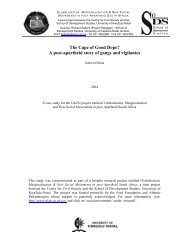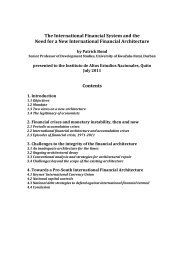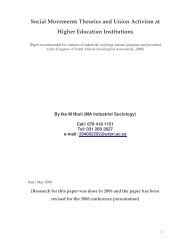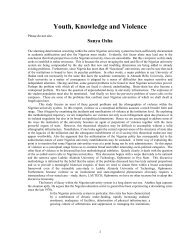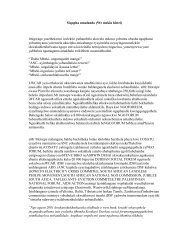April 2011 - Centre for Civil Society - University of KwaZulu-Natal
April 2011 - Centre for Civil Society - University of KwaZulu-Natal
April 2011 - Centre for Civil Society - University of KwaZulu-Natal
You also want an ePaper? Increase the reach of your titles
YUMPU automatically turns print PDFs into web optimized ePapers that Google loves.
sharp opposition if tries following through his predecessor’s <strong>for</strong>estprivatisation<br />
<strong>of</strong>fset deals in Chiapas, Mexico.<br />
South Africa’s Green Paper authors obviously weren’t paying attention to<br />
the markets, in arguing, “Limited availability <strong>of</strong> international finance <strong>for</strong><br />
large scale fossil fuel infrastructure in developing countries is emerging as<br />
a potential risk <strong>for</strong> South Africa’s future plans <strong>for</strong> development <strong>of</strong> new coal<br />
fired power stations.” If so then why did Pretoria just borrow $3.75 bn<br />
from the World Bank, with around $1 bn more expected from the US Ex-Im<br />
Bank and $1.75 bn just raised from the international bond markets? The<br />
North’s financiers are as short-sighted about coal investments as they were<br />
about credit derivatives, real estate, dot.coms, emerging markets and the<br />
carbon markets.<br />
The Green Paper is also laced with false solutions. For example,<br />
attempting to “kick start and stimulate the renewable energy industry”<br />
requires “Clean Development Mechanism (CDM) projects.” Yet the<br />
miniscule €14/tonne currently being paid to the Durban methaneelectricity<br />
conversion at three local landfills shows the futility <strong>of</strong> the CDM,<br />
not to mention the historic injustice <strong>of</strong> keeping Bisasar Road’s dump<br />
(Africa’s largest) open in spite <strong>of</strong> resident objections to environmental<br />
racism.<br />
Similarly dubious policy ideas include “a nuclear power station fleet with a<br />
potential <strong>of</strong> up to 10 GWh by 2035 with the first reactors being<br />
commissioned from 2022” and, just as dangerously, a convoluted waste<br />
incineration strategy that aims to “facilitate energy recovery” through<br />
“negotiation <strong>of</strong> appropriate carbon-<strong>of</strong>fset funding.”<br />
Talking left (with high-minded intent) to walk right (<strong>for</strong> the sake <strong>of</strong><br />
unsustainable crony-capitalist pr<strong>of</strong>iteering) is a long-standing<br />
characteristic <strong>of</strong> African nationalism, as Frantz Fanon first warned <strong>of</strong> in<br />
The Wretched <strong>of</strong> the Earth in 1961. But the Green Paper fibs way too far,<br />
claiming that SA will achieve an “emissions peak in 2020 to 2025 at 34%<br />
and 42% respectively below a business as usual baseline.”<br />
Earthlife Africa’s Tristen Taylor already reminded Yawitch in 2009 that the<br />
‘baseline’ was actually called “Growth Without Constraints” (GWC) in an<br />
earlier climate policy paper: “GWC is fantasy, essentially an academic<br />
exercise to see how much carbon South Africa would produce given<br />
unlimited resources and cheap energy prices.” Officials had already<br />
conceded GWC was “neither robust nor plausible” in 2007, leading Taylor<br />
to conclude, “The SA government has pulled a public relations stunt.”<br />
And if, realistically, we consider South Africa’s entire climate policy as a<br />
stunt, required so as to not lose face at the Conference <strong>of</strong> Polluters’ global<br />
meeting, then the antidote (short <strong>of</strong> Tunisia/Egypt-style bottom-up<br />
democracy) is louder civil society demands <strong>for</strong> genuine solutions not found<br />
in the Green Paper:<br />
• Turning <strong>of</strong>f the aluminium smelters so as to <strong>for</strong>ego more coal-fired<br />
plants, while ensuring Green Jobs <strong>for</strong> all affected workers (such as solar<br />
hot-water heater manufacture).<br />
• Direct regulation <strong>of</strong> the biggest point emitters starting with Sasol and<br />
Eskom, compelling annual declines until we cut 50 percent by 2020.<br />
• Strengthening the Air Quality Act to name greenhouse gases as<br />
dangerous pollutants (as does even the US Environmental Protection<br />
Agency now).<br />
• A dramatic, urgent increases in investments <strong>for</strong> public transport,


